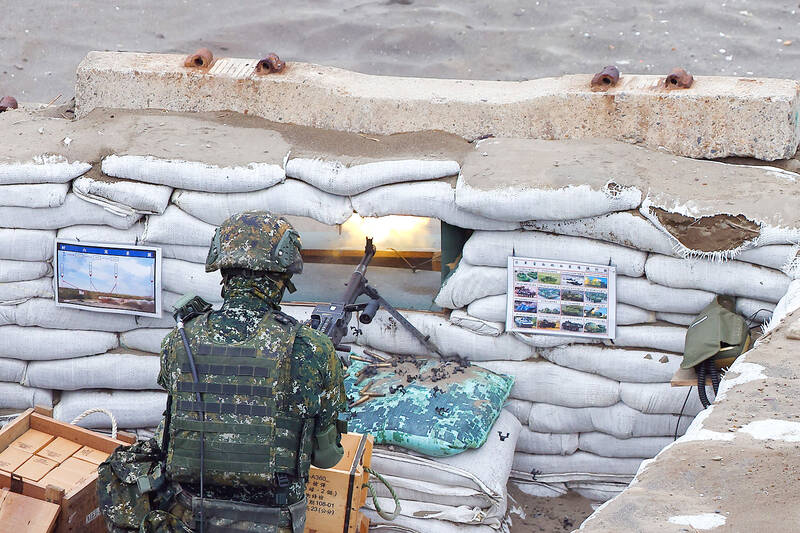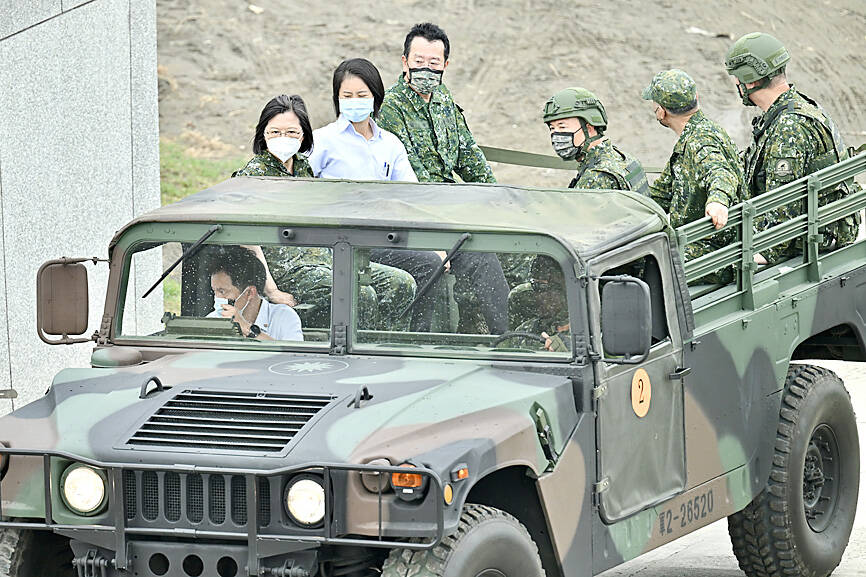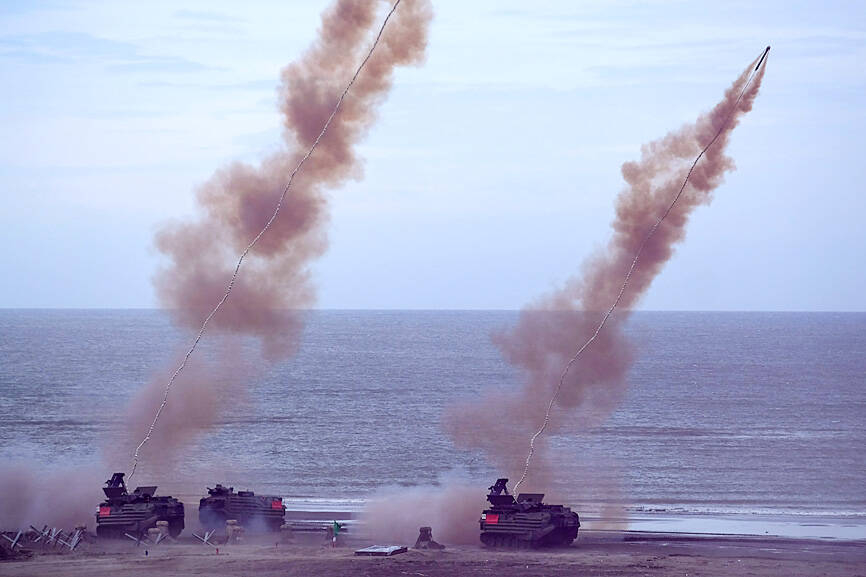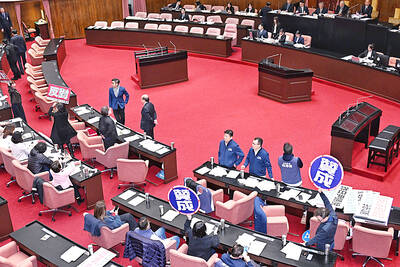The 39th annual Han Kuang military exercises reaffirm Taiwan’s resolute commitment to defending itself, President Tsai Ing-wen (蔡英文) said yesterday while observing the drills in New Taipei City’s Bali District (八里).
The fourth day of the live-fire phase of the exercises yesterday involved an anti-amphibious landing drill near the Port of Taipei in Bali, considered a critical site for repelling a Chinese attack.
Dressed in full military uniform and wearing a mask on her last Han Kuang inspection as president, Tsai boarded a Humvee, accompanied by Minister of National Defense Chiu Kuo-cheng (邱國正) and other senior military personnel, as they inspected the barricades and trenches on the beach, and temporary fortifications under Provincial Highway No. 61.

Photo: Ann Wang, Reuters
It was the second consecutive day that the president was inspecting the live-fire component of the annual drills, which started early on Monday and end today, despite testing positive for COVID-19 on Tuesday.
Tsai said she would never miss a Han Kuang exercise during her presidency, as it is of paramount importance to national security, adding that yesterday’s drills were the largest this year, which tested military cooperation with local police, firefighters and other organizations.
Taiwan’s defenses have taken pointers from the Ukraine-Russia war, utilizing local terrain to make its defensive positions more challenging to bombs or being fired upon, and bolstering overall defense capabilities on the coast, she said.

Photo: Tu Chien-jung, Taipei Times
While the drills demonstrated the nation’s ability to foil an attempt to secure a beachhead, the government cannot rest on its laurels and must continue to make plans that anticipate greater challenges in the future, she added.
In addition to bolstering the military’s overall defensive capabilities, the government should seek to integrate police, firefighters, local militias and other organizations into its defense plans to realize the goal of having the public take up arms in defense of the country, she said.
Tsai thanked the military on behalf of the public for its dedication to being the nation’s bulwark.

Photo: Sam Yeh, AFP
During a simulated beach invasion, troops from the Sixth Army Corps posed as “red” invading forces and “blue” defense ground troops, the Ministry of National Defense said.
The 30-minute drill began with the red invading troops making a forced landing on Bali beach in 20 AAV7 amphibious assault vehicles, the ministry said.
To repel the attack, the blue team deployed tanks and indigenous CM-32 Clouded Leopard armored vehicles, while also erecting barricades and digging trenches on the beach to slow the enemy’s advance.
Uncrewed aerial vehicles were also deployed to determine the enemy forces’ coordinates, which were then transmitted to a command center that mobilized ground forces in a counterstrike.
Meanwhile, a “blue” infantry soldier was seen armed with FGM-148 Javelin missiles in the trenches.
The portable anti-tank missiles have drawn wide attention because of their effective use by Ukraine to take out Russian tanks.
In the invasion simulation in Bali, defense troops also detonated explosives and smoke grenades to obscure the view of the invading forces and facilitate covert movements by the blue team, while the red team continued to advance on the beach under the cover of AH-64E and UH-60M attack helicopters.
As part of the Bali anti-amphibious landing drill, infantry troops stationed at a nearby temporary coastal fortification took up their designated positions in a 150m-long trench.
The fortification, which was set up under an elevated section of Provincial Highway No. 61, served as a second line of defense during the drill, allowing blue soldiers to eliminate members of the red invading forces who were advancing from the beach with tanks and artillery.
Some parts of the anti-landing drill were canceled due to strong winds from Typhoon Doksuri, including participation by the air force and navy, which were supposed to deploy fast mine-laying boats and the newly commissioned indigenous Yushan landing platform dock, a naval warship used to transport landing craft such as amphibious vehicles.
The ministry said that the Port of Taipei, Bali beach and Tamsui River (淡水河) estuary are strategic sites, comprising key defensive positions for fending off a potential seaborne invasion by the Chinese People’s Liberation Army.
Defending the area near the mouth of the Tamsui River has always been a priority for the military, because if it is breached by enemy forces, they could easily advance into the Greater Taipei area, the center of political and economic facilities, the ministry said.
Since they were first launched in 1984, the Han Kuang exercises have served as Taiwan’s major military drills, comprising live-fire exercises and computerized war games that are meant to test the nation’s combat readiness in the event of an invasion by China.
This year’s tabletop exercises were staged in May.

A magnitude 7.0 earthquake struck off Yilan at 11:05pm yesterday, the Central Weather Administration (CWA) said. The epicenter was located at sea, about 32.3km east of Yilan County Hall, at a depth of 72.8km, CWA data showed There were no immediate reports of damage. The intensity of the quake, which gauges the actual effect of a seismic event, measured 4 in Yilan County area on Taiwan’s seven-tier intensity scale, the data showed. It measured 4 in other parts of eastern, northern and central Taiwan as well as Tainan, and 3 in Kaohsiung and Pingtung County, and 2 in Lienchiang and Penghu counties and 1

A car bomb killed a senior Russian general in southern Moscow yesterday morning, the latest high-profile army figure to be blown up in a blast that came just hours after Russian and Ukrainian delegates held separate talks in Miami on a plan to end the war. Kyiv has not commented on the incident, but Russian investigators said they were probing whether the blast was “linked” to “Ukrainian special forces.” The attack was similar to other assassinations of generals and pro-war figures that have either been claimed, or are widely believed to have been orchestrated, by Ukraine. Russian Lieutenant General Fanil Sarvarov, 56, head

FOREIGN INTERFERENCE: Beijing would likely intensify public opinion warfare in next year’s local elections to prevent Lai from getting re-elected, the ‘Yomiuri Shimbun’ said Internal documents from a Chinese artificial intelligence (AI) company indicated that China has been using the technology to intervene in foreign elections, including propaganda targeting Taiwan’s local elections next year and presidential elections in 2028, a Japanese newspaper reported yesterday. The Institute of National Security of Vanderbilt University obtained nearly 400 pages of documents from GoLaxy, a company with ties to the Chinese government, and found evidence that it had apparently deployed sophisticated, AI-driven propaganda campaigns in Hong Kong and Taiwan to shape public opinion, the Yomiuri Shimbun reported. GoLaxy provides insights, situation analysis and public opinion-shaping technology by conducting network surveillance

‘POLITICAL GAME’: DPP lawmakers said the motion would not meet the legislative threshold needed, and accused the KMT and the TPP of trivializing the Constitution The Legislative Yuan yesterday approved a motion to initiate impeachment proceedings against President William Lai (賴清德), saying he had undermined Taiwan’s constitutional order and democracy. The motion was approved 61-50 by lawmakers from the main opposition Chinese Nationalist Party (KMT) and the smaller Taiwan People’s Party (TPP), who together hold a legislative majority. Under the motion, a roll call vote for impeachment would be held on May 19 next year, after various hearings are held and Lai is given the chance to defend himself. The move came after Lai on Monday last week did not promulgate an amendment passed by the legislature that